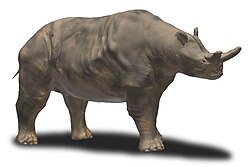This article about White River Fauna includes a list of references, related reading, or external links, but its sources remain unclear because it lacks inline citations .(December 2021) |
The White River Fauna are fossil animals found in the White River Group of South Dakota, North Dakota, Wyoming, Colorado and Nebraska in the United States. In southwest South Dakota and northwest Nebraska, these fossils are characteristic of the White River Badlands (including Badlands National Park), though they can be found far beyond the limits of the White River watershed. [1]
Contents
- Birds
- Mammals
- Artiodactyls
- Creodonts
- Carnivorans
- Epoicotheres
- Lagomorphs
- Perissodactyls
- Rodents
- Reptiles
- Crocodilians
- Lizards
- Snakes
- Turtles
- Amphibians
- See also
- Further reading
- References
In Wyoming, the White River Group is undifferentiated, and is more commonly known as the White River Formation. Further east in Nebraska and South Dakota, the group is divided into the Chadron Formation (lower part) and Brule Formation (upper part). Exposures are less well-investigated in northeast Colorado and scattered sites across western North Dakota. The White River Group is overlain by the Sharps Formation in Badlands National Park and the Arikaree Group in northwest Nebraska.
Animals from the White River Group date from the Eocene and Oligocene epochs. The fauna is representative of four North American Land Mammal Ages (NALMAs):
- Arikareean (late Oligocene - early Miocene, 29.5 - 18.5 million years ago)
- Whitneyan (mid-Oligocene, 31.8 - 29.5 million years ago)
- Orellan (early Oligocene, 33.9 - 31.8 million years ago)
- Chadronian (late Eocene, 37 - 33.9 million years ago)
































